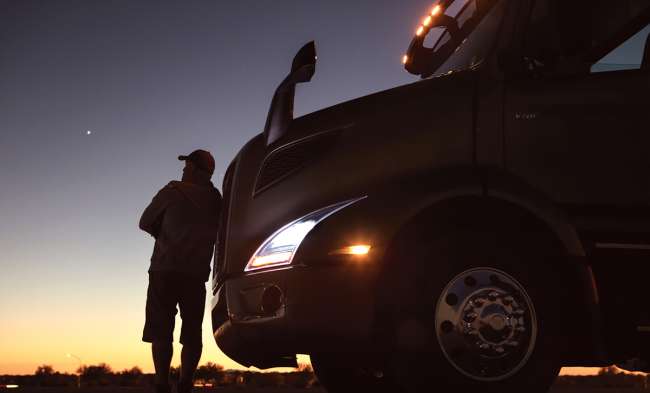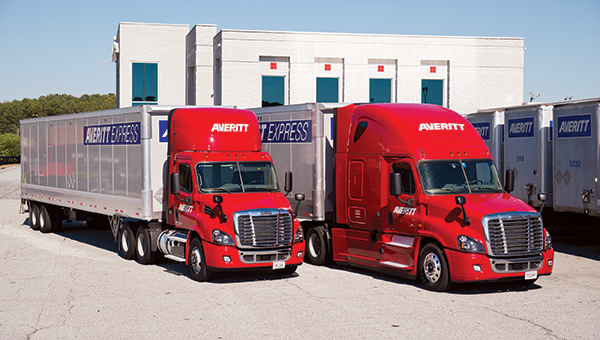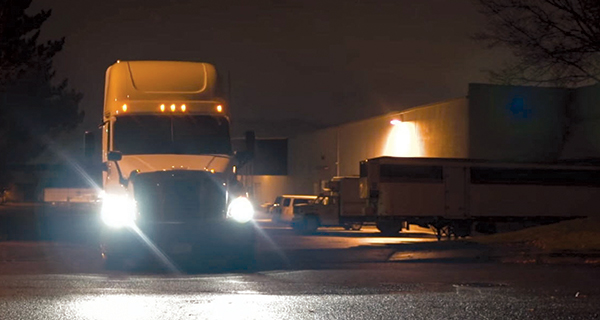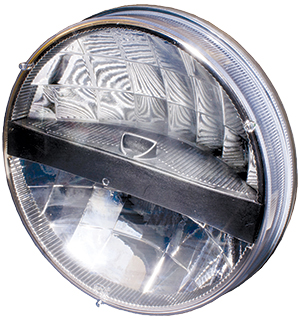Lighting the Way

Today’s fleets are increasingly shifting toward LED headlights, not only for truck drivers’ safety but also to improve maintenance and the overall operation of the truck, industry experts said.
Headlamp technology has grown in importance in its contribution to the safe and prudent operation of trucks on the highways of our nation,” said Dwayne Haug of Dwayne O. Haug Consulting, a Missouri-based consultant to the transportation industry for more than 40 years.
With the growing number of trucks that are sharing the roads with the motoring public along with increased congestion, “proper lighting is of ever-increasing importance,” Haug said.
Drivers depend on headlights for reliable illumination as they drive on highways and other roadways, often in adverse weather conditions, to deliver goods every day.
“Headlights continue to be one of the most important safety systems on the vehicle, as so much driving is done in the overnight hours,” said John Hansen, senior project engineer for Peterson Manufacturing, which makes headlights for heavy trucks. “Traditional headlight technology is simply not up to the task of adequately illuminating the road and surroundings for driving at highway speeds with long slowing [and] stopping distances taken into account for loaded vehicles.”
Older halogen or incandescent headlights which many vehicles still are equipped with have posed challenges for maintenance due to exposure and gradual degradation.
“Manufacturers use a coating. The sun’s [ultraviolet] rays, as well as exposure to the weather, affect the coating. Headlights get dimmer and dimmer. This cuts down on driver vision tremendously,” said Duke Drinkard, a retired vice president of maintenance for Southeastern Freight Lines, who also was chairman of the Future Truck Committee of American Trucking Associations’ Technology & Maintenance Council.
In a 2015 TMC position paper, which is the council’s current guidance on the subject, the committee stated that the headlight lenses of today’s vehicles are subject to UV light damage and cleaning solutions that are not compatible with the lenses. “This damage diminishes the light needed for clear vision by the driver. New materials need to be developed for the lenses that will not be affected by UV rays or the cleaning solutions in use today.”
In the past, incandescent headlights required frequent maintenance and put the
driver at risk of violations under the Federal Motor Carrier Safety Administration’s Compliance, Safety, Accountability program if the lights were inoperable or did not provide sufficient lighting, said Brett Johnson, CEO of Optronics International, a manufacturer of vehicle lighting.
Low-end incandescent models produce a “dirty,” yellow-tinged beam that doesn’t optimize visibility, Johnson said. “High-end [high-intensity discharging] options improve beam color and intensity, but the cost and maintenance required make this a dubious choice versus maintenance-free LED options,” Johnson said. “LEDs last up to 50 times longer than incandescent bulbs, operate at lower amperages, and better withstand moisture, shock and vibration.”
LED lights, which tend to be cooler, provide greater brightness and last longer, and are a welcome addition to new fleet technology, industry experts said. LED lights are now becoming common on fleet vehicles throughout the United States.
“We implemented LED lights throughout our entire fleet three years ago,” said Doug Lloyd, director of fleet maintenance at Averitt Express. “They are utilized not only on the outside of the tractor but inside the cab and trailer as well.”
“Our drivers have been very receptive to the change from traditional to LED lighting. Their feedback has signaled that nighttime visibility has improved as a result,” Lloyd said, noting it’s an added safety improvement that benefits drivers and the motoring public.

Averitt Express uses LED lighting across its fleet of less-than-truckload and over-the-road tractors and trailers. (Averitt Express Inc.)
Averitt Express Inc., based in Cookeville, Tenn., ranks No. 31 on the Transport Topics Top 100 list of the largest for-hire carriers in North America.
Lloyd added that compared with standard lighting, the LED systems make a lot of sense from a cost-efficiency standpoint.
“They will most likely last the lifetime of the tractor, which in Averitt’s case is approximately five years,” he said. “In most cases, the traditional lights had a lifespan of just about three years.”
Aside from the general costs of parts and labor in maintaining and replacing traditional lights, tractors would ordinarily be pulled out of service for changing and maintaining lights, Lloyd said. Now, with the longer-lasting LED lights, Averitt can avoid those setbacks and reduce the potential costs of delaying drivers and shipments.
Other fleets also are gravitating toward LED lighting.
“When the time comes for headlight change-out, we’re switching to LED,” said Rich Casoli, vice president of Beemac Trucking in Ambridge, Pa. “It’s something recommended by our dealers. We know the life cycle value too,” he said, noting his fleet has received positive feedback from its drivers that the lights are much brighter.
Today, truck manufacturers are including LED headlights as standard equipment.

Better headlights help improve drivers' safety, experts say. (Truck-light via YouTube)
“The new Volvo LED headlamps are designed to operate up to 10,000 hours,” said Jason Spence, Volvo Trucks product marketing manager for longhaul. “In most cases, this means that the lamps are good for the usable life of the vehicle.”
Volvo also redesigned the forward lighting on its new VNR and VNL series to not wrap around the fender side like the last generation, Spence said. “This reduces the chance that the headlamp will need to be replaced if the hood is damaged.”
However, there are some caveats in replacing or converting halogen lamps to more modern headlight technology such as LED, said Andrew Liuzzo, a spokesman for Truck-Lite, which produces lighting equipment for trucks and vehicles.
Although replacement kits may be readily available, they may not be Department of Transportation approved. “Any replacement bulb kit designed to convert halogen lamps to HID or LED must be clearly marked with the DOT symbol,” Liuzzo said. “These kits, although available, do not currently meet DOT standards for beam pattern when placed in a reflector that was designed for a halogen bulb.”
In addition, LED replacements “often compromise a vehicle’s electrical system due to poor thermal management, resulting in melted sockets or connecting wires,” Liuzzo said.
He also recommended that vehicles equipped with halogen headlamps stick with replacement bulbs called out by the manufacturer. Use of illegal HID or LED kits in the headlamps “will cause glare levels too high for oncoming drivers to be safe,” Liuzzo said. “Avoid using bulbs labeled for ‘off-road use only,’ as they often damage your headlamp so that it cannot be repaired.”
LED headlights are expected to be commonplace in truck fleets in the years ahead.
“We all recognize that safety is a huge focus for trucking technology,” said Greg Emery, vice president of business development for BG Innovative Safety Systems, a firm that manufactures and supplies lighting for vehicles and fleets. He added that equipment maintenance and change-out can be disruptive to the driver, who is under pressure to meet delivery schedules. The ability to predict when equipment needs replacement is important.

Great White LED 7-inch round headlight, Peterson Manufacturing
“We see that same need in headlights,” he said. “Some drivers can replace their own bulbs, but they are now a small minority. So getting off the road, in addition to jeopardizing on-time delivery, results in unscheduled downtime and extra cost to have a bulb replaced by a service center.”
Jessil Joseph, of Grote Industries, a manufacturer and supplier of LED lights and lighting products for heavy-duty trucks, said the transition toward LEDs continues to happen. More truck OEMs are looking for custom headlamps as their customers are requesting styling requirements, Joseph said. He added that “smart” lighting, which incorporates sensors and controls into the lighting system, also is starting to appear.
Spence said Volvo’s newer LED headlamps have features that drivers appreciate. They’re brighter with much better visibility patterns and illuminate potential obstacles sooner, allowing more time for the driver to react, he said.
“The new lights also have the ability to defrost once the outside temperatures get down to freezing,” Spence said. “An innovative design pulls heat from a heat-sink at the rear of the headlamp assembly and directs it to the exterior surface, melting ice and frost from the lenses. The same fan system acts to cool the lights when used in warmer temperatures, extending the usable life.”
Haug, meanwhile, believes better headlights not only improve safety, but also help drivers perform their demanding jobs.
“With the variety of OEM cab configurations today, the need for long life and proficient headlamp technology is of great importance,” Haug said. “Driver and safety demands are of huge concern. Headlamp technology must keep up with new and increasing demands.”


